|
British POWs abroad
|
Foreign POWs around Gatehouse
|
||
|
Internees
|
Evacuees
|
||
|
In June 1945, the Galloway News stated that there had been 73 men from the Stewartry of Kirkcudbright held prison in European POW camps. 38 men were in Japanese POW camps. We do not know how many Gatehouse men are included in these numbers but here are a few: Major Walter McCulloch, from Ardwall, was fighting in France at the beginning of the war when he was captured by the Germans. He spent most of the war in German POW camps. He was also the first Gatehouse man to return home in May 1945. Private Colin Bennett also spent a lengthy time (5 years) in German POW camps and he too, was released in May 1945. Corporal Stanley McCutcheon, who had previously lived at Goatend, Gatehouse was also imprisoned in Germany for 5 years. |
|
||
|
|
After the Battle of Arnhem in September 1944, which was a German victory, Private John McInally KOSB (Airborne Division), was reported as wounded and missing. By November 1944 he was reported as a POW in German hands. Also captured at Arnhem was Lieutenant Corporal W Shedden of K.O.S.B. Airborne Division. His mother Mrs R.J. Shedden lived in Neilson Square, Gatehouse. (Galloway News 08/07/1944) In August 1944 Trooper James Carson, Recce Regiment, (Reconnaisance) Royal Armoured Corps was reported missing. In November the same year, the Galloway News reported that he was now a Prisoner of War in Germany. Prior to the war Jim, as he was known, lived with his sister and brother in law, Ina and Jasper Proudlock. He worked as a gardener at Cushat Wood and was 'called up' when he was 18. |
||
By June 1945 all the British POWs in German camps were accounted for and most had returned home. A number of Gatehouse men were captured after the Fall of Singapore to the Japanese Imperial Army on February 15th 1942.
Pte Thomas Gemmell of Argyll & Sutherland Highlanders was a POW of the Japanese. His parents were Mr & Mrs Gemmell, Railway Cottages, Gatehouse Station. Their youngest son, Alfred Gemmell, was in the Royal Navy and was killed in 1942.
Tommy was posted missing in 1942 and was imprisoned for over 3 years in Malaya. He was one of the men who helped with construction of the notorious Burma to China railway, known as the 'Death Railway', and which was featured in the film' Bridge over the River Kwai'.
In September 1944 he was being transported from Thailand to Japan when his transport ship sank. It was not until March 1945 that his mother learned that he had been rescued and was in Fukuoba Camp in Japan.
The Galloway News 20th October 1945 announced that Tommy had been released from prison. He had been a prisoner for over 3 years.
|
In April 1942 Mr & Mrs J M Shaw, Ornockenoch, were informed that their son Gunner Robert Shaw, of the A.A. (anti-aircraft) was posted as missing in Singapore. He was originally a member of the Kirkcudbright Battery of the Royal Artillery. In September 1945 the Shaws heard that Robert, known as Bobby, was safe. He had been taken prisoner in Malaya. James McKenzie (Jim) , a fitter in the RAF, was also a prisoner in the Far East. He was involved in an escape attempt. During his re capture he sustained a severe head injury which caused him problems for the rest of his life.
|
|
||
The Galloway News reported in June 1945 that there were between 8 and 9 million displaced persons in Europe.
Some would have been driven out of their homeland and some had become prisoners of war.
A Prisoner of War is someone who has been involved in armed conflict who has been ‘captured’ by his enemy. POWs are held under the conditions of the Geneva Convention, which ensures that prisoners should be treated humanely. A large number of enemy forces who had been captured after battles in Europe were held in camps all over the UK and there were several around Galloway. The Isle House Stables Camp at Kirkcudbright held Italians as did a camp near Twynholm graveyard. The Kirkcudbright town council expressed concerns for the local female population with so many handsome young Italians around! Holm Park at Creebridge, Newton Stewart initially held Italians and later German Luftwaffe pilots. After the war it became a camp for displaced persons - people who could no longer return to their homeland which was now behind the Iron Curtain. It is now the site of a caravan park.
|
Some of the men were given work to do in gangs - for example in the forestry. Others were chosen to work as individuals on farms sometimes being billeted at their place of work. Herman Heil was an example of the latter. He first worked for the Finlay family at Ross, near Borgue, when he was in the POW camp near Twynholm, and then at Rainton Farm. After the war he remained friendly with the Finlay family and returned for visits to Rainton with his family for holidays. When the war ended some of the POWs could not go back home. A number had been reluctant to fight at all and feared reprisals, others now found that their homes were behind the Iron Curtain. They chose to remain in Britain after the war ended. Josef Salfenmoser was from a small German village near Munich and Nikolai Rotomir, from Sarajevo, Yugoslavia. Both men had been PoWs and remained in Gatehouse after the war ended. |
|
Josef Salfenmoser and Herman Heil both fought in the German Army.
Josef Salfenmoser chose to remain near Gatehouse after the war ended. He married Elspeth McMillan in 1949 and the couple raised a family in the area. Josef died in 2008.
Nikolai Ratomir was from Sarajevo, Yugoslavia. He had married Spasenija and had a son Milan before the war but, afterwards he became a 'displaced person' as his home was now behind the Iron Curtain. He worked for Andrew Graham the builder and latterly was a popular employee at the Cally Hotel. He died in 2010.
Internment was introduced when war started, to hold foreign nationals who were living in Britain, whose country of birth is an enemy state, and who therefore may be believed to pose a threat and have sympathies with the enemies’ war objectives. This included over 70,00 Germans and Austrians.
10th June 1940 after Italy entered the war, Italian nationals were also included.
The internees were examined by internal tribunals and graded into 3 categories
A - Internment in a camp
B - Exempt from internment but with restrictions
C - Exempt from all restrictions.
Many German Jews who had fled the Nazis, like Wolfgang Schmidt (Antony Wolffe), found themselves in categories A and B.
There were a number of Internment Camps around the UK but most were on the Isle of Man. When space ran out internees were sent to other colonial countries like Canada, Australia and New Zealand. Transportation by boat was dangerous. On July 2nd 1940 the Arandora Star was torpedoed in the Atlantic with a great loss of life including, Italians, Germans, British soldiers and seamen. This helped to sway sympathy towards the enemy aliens. Many like Giulio Frullani and his brothers, who had lived in Scotland since the early 1900s, were released later that year.
|
|
1940 notice of release from internment |
The Frullani family had migrated to Scotland from Italy in the early 1900s. At first they worked as miners. One brother was a coal miner in Ayrshire while Guilio came to Gatehouse to work in the Castramont copper mine.
By 1914 Guilio, known locally as Johnny, had bought a shop and cafe in the High Street and was also selling ice cream from a cart.
When war broke out Guilio and 2 of his brothers (one from Wigtown and one from Dailly, Ayrshire) were all interned on the Isle of Man. They were all released in 1940.
When war began in September 1939, it was decided to evacuate vulnerable people from cities where there were major industrial sites that could be targets for bombing raids. Before the end of 1939 over 62 thousand had become evacuees in Scotland, most of which were schoolchildren. Gatehouse was a prime location to care for evacuee children, predominantly from Glasgow.
The Galloway News, in October 1944, reported that 1302 unaccompanied children had cpme from Glasgow to the Stewartry as well as 1643 from other cities. These evacuees included mothers with babies and also all the children from Hillhead High School.
There was no time for organised medical checks before the children left their homes and host families were shocked by the poor health of the children. One evacuee later confessed that the only gift she gave her kind host family was scabies.
Equally the evacuees found the countryside to be an alien environment. There were few entertainments and new strange discoveries e.g. milk came from cows not from a bottle!
Children were usually transported to their evacuation locations by train, most of those destined for Gatehouse arrived at Dromore or Kirkcudbright, with onward journeys by bus into the town. They were taken to a reception centre at the Rutherford Hall where they were distributed at random to host families, with an attempt to keep brothers and sisters together. The WRVS and the churches played a big part in organising this process.
Nessie Alexander and her brothers Alex and James, arrived at Gatehouse on 4th September 1939. She recalled that she and her 2 brothers were the last to be chosen from the reception centre. Rev. Easton, Minister of Girthon Church, a single man, took pity on the family and they were billeted at Girthon Manse (then at Disdow road-end) for six weeks and looked after by Mr Easton's housekeeper.
Little attempt was made to billet children with families of the same religion although a Jewish boarding school was opened at Ernespie House in Castle Douglas.
Some larger houses were used for groups of children.
Cally House, 1 mile from the centre of Gatehouse, was rented by Glasgow Education Authority as a temporary boarding school for Glasgow evacuees, providing accommodation and teaching for about two hundred 12 to 17 year-olds at a time. Pupils joined in activities with the local scouts and guides and some older boys and 2 teachers joined the local Home Guard.
Football matches took place and the Cally School held concerts for local war funds.
The teachers at Cally, and other evacuated schools, were expected to move with their pupils regardless of their other family commitments. Miss Marlin and Miss McHaffie came from Glasgow and taught at Gatehouse School.
Click to see more details of pupils, photos and other information about Cally House School.
Rusko House, 2 miles outside Gatehouse was owned by the Cochrane family. About 16 children were billeted there and were looked after by Misses Molly and Evelyn Cochrane and staff. After Rev. Easton joined the forces as a chaplain in late 1939, the Alexander family joined the evacuees at Rusko House. Cecilia Cochrane has written a story about her experiences with the evacuees.
|
|
|
|
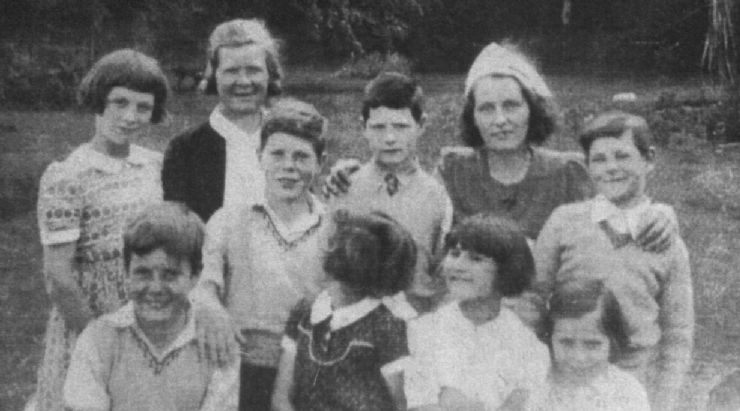
Back: May Munro, Aunt Mary Munro, John Munro, Jessie the maid and James Lindsay
Front: James & Alex Alexander, Cathie and Annie Munro & Nessie Alexander
|
Host families were paid a standard allowance of 8/6 per week per child if they took 2 or more evacuees. A family providing ‘lodgings only’ for a mother and children were paid 5/- per week. The threat to Glasgow docks did not materialise for some time and many mothers and children returned home in 1940. When Glasgow, and Clydebank in particular, was badly bombed in March and May 1941 a new, smaller scale evacuation took place. Apart from health problems, many of the evacuees experienced problems of separation from their families Some mothers chose to stay nearby but many returned to the city and only visited their children occasionally when a bus trip could be arranged. There were also some complaints about the poor behaviour of evacuees. In some areas special provision was made for badly behaved children. Some of the children like Nessie Alexander enjoyed their experiences in Gatehouse. She had arrived at Rusko as a seven year old and left 4 years later in January 1943. They loved the freedom of the countryside and the companionship of their fellow evacuees. Some like Marion Connell retained a lifelong friendship with their host families. It is unclear how many evacuees came to Gatehouse but it had an impact on the number of pupils attending Gatehouse School and the Education Authority had to rent the Rutherford Hall and Town Hall to be used as extra classrooms, dining room and gym hall. |
|
The evacuation scheme was suspended in September 1944 although it took some time for all the children to be returned to their homes. Here is a list of those evacuees who are known to have stayed in Gatehouse that we know about (excluding those at Rusko House and Cally House School).
|
Other Evacuees Augustina and Antonio (Tony) Perez came to Gatehouse during the Spanish Civil War (1936 to 1939), probably after the bombing of the Basque town of Guernica in 1937. This war overlapped with World War II so the Perez children remained in Gatehouse until after 1945. Augustina then left Gatehouse but Tony remained until the 1950s. At least one family purchased a house in Gatehouse during the war years to escape the worst of the bombings. Tom and Elma Gibson purchased Woodlyn in Castramont Road in 1939. Tom worked for the British Iron & Steel Corporation in London, where their son Ninian was born in 1933. Mrs Gibson, young Ninian, and a baby daughter Isobel Mary spent most of the war years in Gatehouse. Ninian attended Gatehouse School and unusually, he always wore a kilt. (His parents were staunch Scottish Nationalists.) |
|
Some evacuees came from much further away.
The Wright family lived at the Sheiling at Skyreburn during the war years. Douglas, Keith and Peter all attended Skyreburn School at different times between 1943 and 1945. Douglas went to Kirkcudbright Academy between 1945 & 1946.
Their father, Henson Wright, was a tea planter in Assam, India. Mother Helen, whose parents lived in Kirkcudbright, made a very long and hazardous journey to Britain with her children in 1942. The family returned to live in India in 1946, after the war
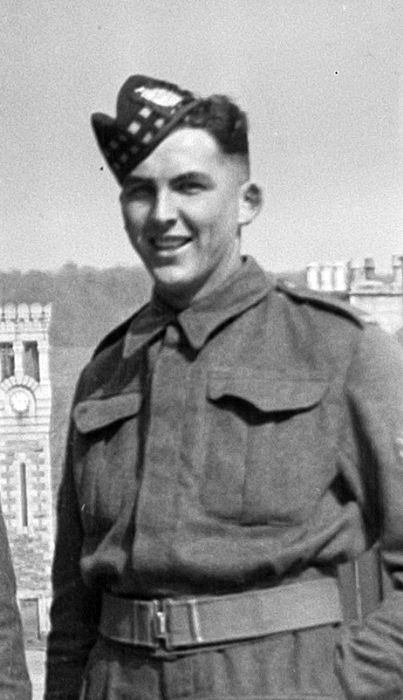
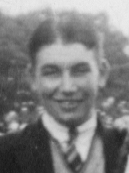
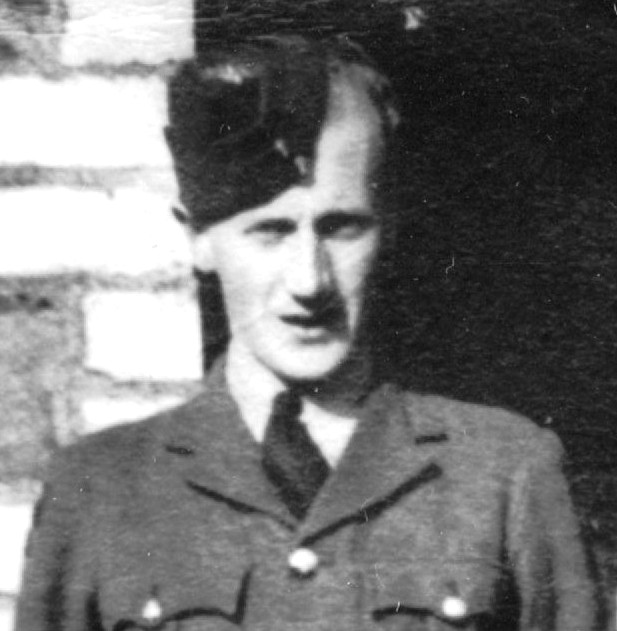
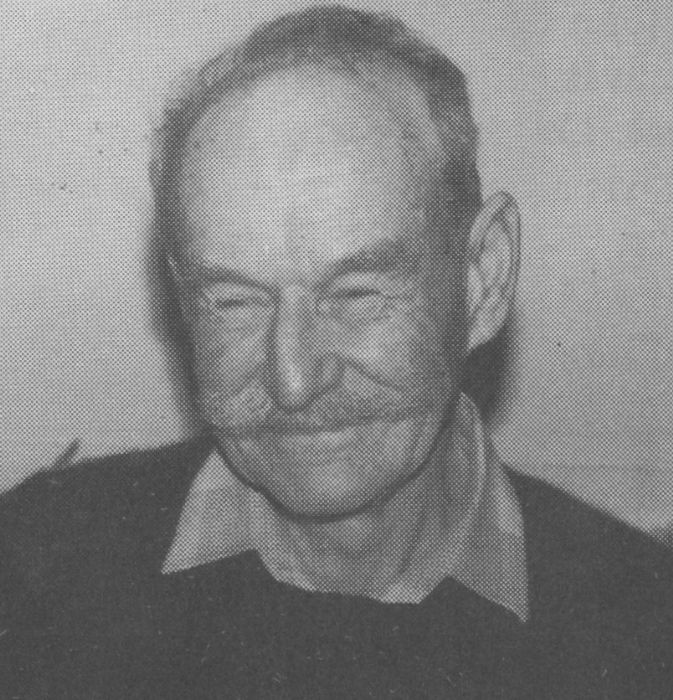
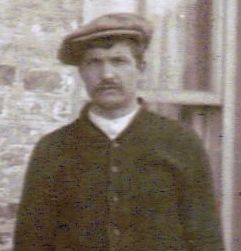
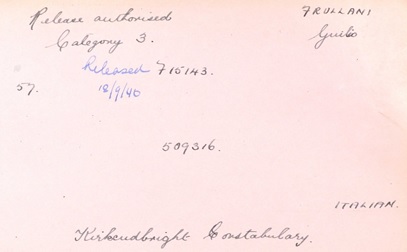
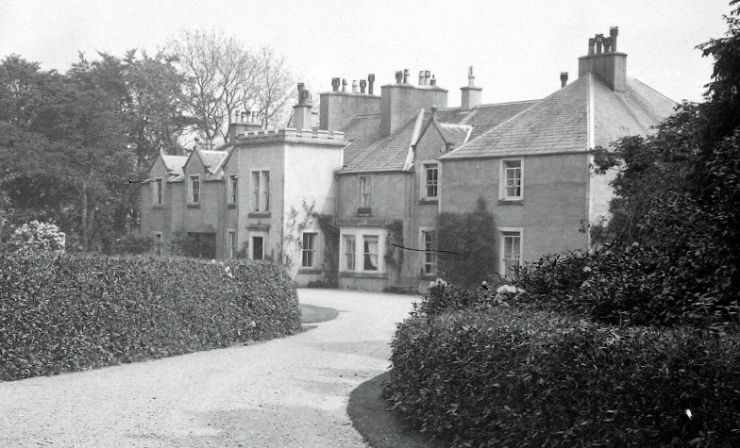
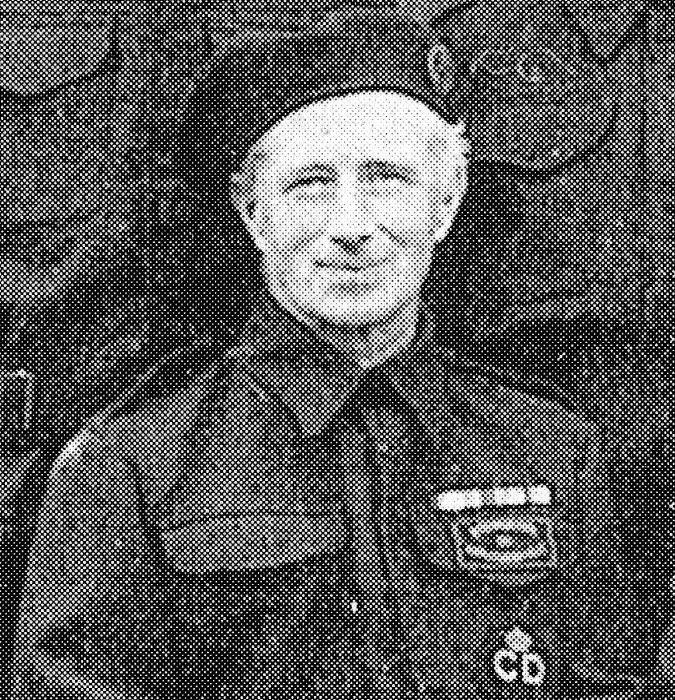
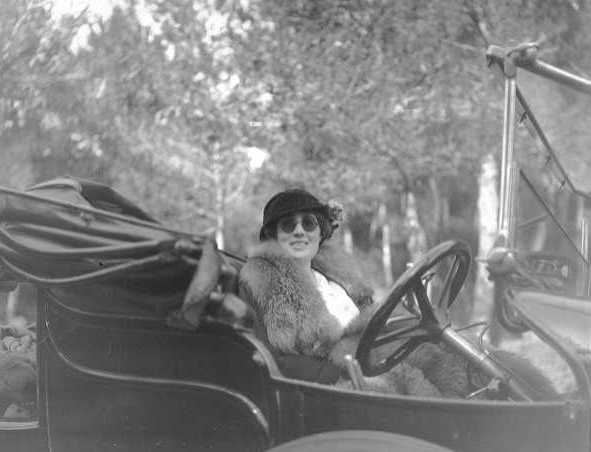
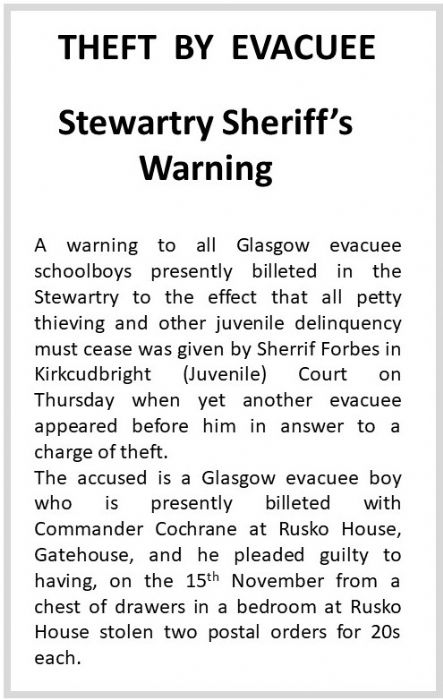
 Tony Perez
Tony Perez